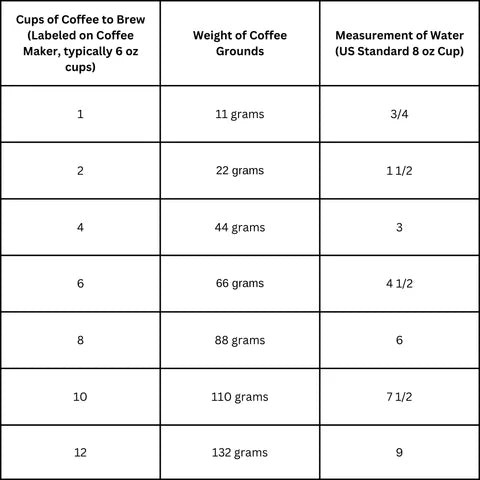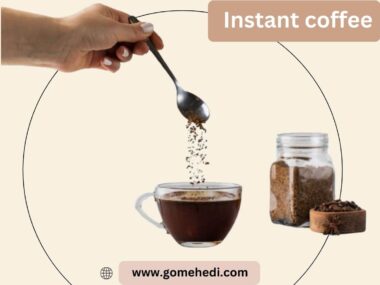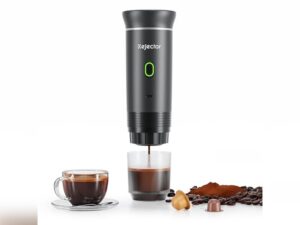You need four scoops of coffee for four cups. This is the general rule.
But, there are some factors to consider to brew the best coffee. Brewing coffee is an art. The right amount of coffee grounds can make a huge difference in taste. Many people wonder about the perfect scoop-to-cup ratio. In this guide, we will help you understand the basics.
We will explore how to get the best flavor. We will also share some tips. By the end, you will know how to make the perfect cup of coffee. Ready to dive in? Let’s get started!
Coffee Scoop Basics
Brewing the perfect cup of coffee depends on many factors. One of the most important is the amount of coffee used. Using the right number of scoops ensures a balanced and flavorful brew. In this section, we will discuss coffee scoop basics to help you make 4 cups of delicious coffee.
What Is A Coffee Scoop?
A coffee scoop is a tool used to measure coffee grounds. It helps maintain consistency in the amount of coffee used per cup. One standard coffee scoop usually holds about 2 tablespoons of coffee. This measurement is crucial for brewing a well-balanced coffee.
Using a coffee scoop can be more convenient than using a regular spoon. Here are some benefits:
- Precision: Ensures the right amount of coffee each time.
- Consistency: Helps maintain the same taste with every brew.
- Ease of Use: Simple and straightforward to measure coffee.
For 4 cups of coffee, you would typically use 4 scoops, assuming each scoop is 2 tablespoons. This ensures you have the right coffee-to-water ratio. If your scoop size differs, adjust the number of scoops accordingly to maintain the same total amount of coffee.
Here is a table to help you understand the coffee-to-water ratio better:
| Number of Cups | Number of Scoops |
|---|---|
| 1 Cup | 1 Scoop |
| 2 Cups | 2 Scoops |
| 4 Cups | 4 Scoops |
Different Types Of Scoops
Not all coffee scoops are the same. They come in different shapes, sizes, and materials. Choosing the right scoop can make a difference in your coffee-making process.
Here are some common types:
- Standard Plastic Scoop: Simple and affordable. Usually holds 2 tablespoons. Not very durable.
- Metal Scoop: More durable than plastic. Often made from stainless steel. Maintains its shape over time.
- Adjustable Scoop: Allows you to measure different amounts. Can be set to 1, 2, or more tablespoons.
- Digital Scoop: Comes with a built-in scale. Measures coffee by weight rather than volume.
Each type has its pros and cons. Plastic scoops are lightweight and inexpensive, but they may not last long. Metal scoops are durable and easy to clean. Adjustable scoops offer flexibility, while digital scoops provide precision.
When choosing a scoop, consider how often you make coffee and your preference for measurement accuracy. For daily use, a durable metal scoop or an adjustable scoop might be best. For those who want precise control over their coffee, a digital scoop can be a great choice.
Understanding these basics can help you make the perfect cup of coffee, every time.

Credit: www.facebook.com
Standard Coffee Measurements
Determining how many scoops of coffee for 4 cups can be tricky. Knowing the standard coffee measurements makes this task easier. The right balance of coffee and water ensures a perfect brew every time. This guide will help you understand the standard measurements and how they apply to your daily coffee ritual.
Cup Size Variations
Understanding cup sizes is essential. Not all cups are the same. A “cup” in coffee terms can mean different things. Here are some variations:
- Standard Cup: Typically 8 fluid ounces.
- Metric Cup: Often used in recipes, equals 250 milliliters (about 8.45 fluid ounces).
- Coffee Maker Cup: Usually 5 fluid ounces.
For most drip coffee makers, a cup is 5 ounces. So, 4 cups in a coffee maker equals 20 ounces. Knowing your cup size helps in measuring the right amount of coffee.
| Type of Cup | Volume (Fluid Ounces) |
|---|---|
| Standard Cup | 8 |
| Metric Cup | 8.45 |
| Coffee Maker Cup | 5 |
Using the right measurement ensures you get the same taste every time. This consistency is key for coffee lovers. Always check your coffee maker’s manual to know its cup size.
Common Ratios For Brewing
Brewing coffee involves precise ratios. The most common ratio is 1:15. This means 1 part coffee to 15 parts water. For 4 cups of coffee (20 ounces), use 1.33 ounces of coffee.
Here is a simple guide:
- Use 2 tablespoons (1 coffee scoop) per 5-ounce cup.
- For 4 cups, use 8 tablespoons (4 scoops).
- Adjust to taste if needed.
Here’s a quick reference:
| Cups of Coffee | Tablespoons of Coffee |
|---|---|
| 1 | 2 |
| 2 | 4 |
| 4 | 8 |
Using the right ratio ensures a rich and flavorful cup. Too much coffee can be bitter, too little can be weak. Experiment with these ratios to find your perfect brew. Remember, fresh, high-quality coffee makes a big difference.
Brewing Four Cups
Brewing four cups of coffee can be tricky if you don’t know the right amount of coffee to use. Finding the perfect balance between coffee and water is essential for a delicious cup. Let’s explore how many scoops of coffee are needed for four cups and how to adjust it based on your taste preferences.
Calculating The Right Amount
To brew four cups of coffee, you need to measure the coffee grounds accurately. The standard coffee scoop is about 2 tablespoons. For a balanced cup, the general rule is to use one scoop (2 tablespoons) per cup of water. Therefore, for four cups of coffee, you should use four scoops of coffee.
Here is a quick reference table:
| Number of Cups | Scoops of Coffee |
|---|---|
| 1 | 1 |
| 2 | 2 |
| 3 | 3 |
| 4 | 4 |
This ratio ensures a strong and flavorful coffee without being too overpowering. Remember, the size of your coffee cups can vary. A standard cup is typically 6 ounces, but some mugs can hold up to 12 ounces or more. Adjust accordingly if your cups are larger or smaller.
Using a kitchen scale can help achieve precision. Weigh 10 grams of coffee per 6 ounces of water. This method is especially useful if you prefer a more scientific approach to brewing.
Adjusting For Taste Preferences
Taste preferences vary among coffee drinkers. Some prefer a stronger brew, while others like it mild. Here are some tips to adjust your coffee to match your taste:
- Stronger Coffee: Add an extra half scoop or full scoop for a bolder flavor. For four cups, use 4.5 or 5 scoops.
- Milder Coffee: Reduce the amount of coffee by half a scoop. For four cups, use 3.5 scoops.
Experimenting with different ratios can help you find your ideal strength. Keep a coffee journal to note the amount of coffee used and your taste feedback. This can help you consistently brew your perfect cup.
Consider the type of coffee beans and grind size. Finer grinds extract more quickly, resulting in a stronger brew. Coarser grinds take longer, producing a milder flavor. Adjust the grind size to fine-tune your coffee’s strength.
Water quality also plays a role. Use filtered water to avoid any off-flavors. The temperature of the water should be around 195-205°F (90-96°C) for optimal extraction.
By understanding and adjusting these variables, you can enjoy a personalized coffee experience every time you brew.
Grind Size Impact
When brewing coffee, the grind size plays a key role in the flavor and strength of your cup. Understanding how many scoops of coffee for 4 cups is essential, but the grind size can significantly impact your final brew. Let’s explore how the grind size affects your coffee.
Coarse Vs. Fine Grind
The grind size of your coffee beans can change the taste and strength of your coffee. Here’s a breakdown of coarse and fine grinds:
- Coarse Grind: Larger coffee particles. Ideal for French press and cold brew methods.
- Fine Grind: Smaller coffee particles. Best for espresso and Aeropress methods.
A coarse grind is like sea salt. It allows water to flow through the coffee grounds slowly. This results in a smoother and less bitter flavor. The larger particles also mean the coffee takes longer to extract all the flavors.
On the other hand, a fine grind resembles table salt. It offers a larger surface area for water to contact the coffee. This leads to a quicker extraction process and a stronger, more intense flavor. However, it can also result in a more bitter taste if over-extracted.
Here’s a quick comparison:
| Grind Size | Ideal For | Flavor Profile |
|---|---|---|
| Coarse | French Press, Cold Brew | Smooth, Less Bitter |
| Fine | Espresso, Aeropress | Strong, Intense |
Effect On Brewing Time
The grind size also affects the brewing time of your coffee. Let’s look at how:
- Coarse Grind: Longer brewing time.
- Fine Grind: Shorter brewing time.
With a coarse grind, the larger particles need more time to release flavors. This means you will need to brew your coffee for a longer period. For example, a French press requires about 4 minutes of brewing time.
In contrast, a fine grind allows for a quicker extraction. The smaller particles mean the water can extract the flavors faster. Espresso, for instance, only needs about 25 to 30 seconds of brewing time.
Consider this table for a clearer understanding:
| Grind Size | Brewing Time |
|---|---|
| Coarse | 4-5 minutes (French Press) |
| Fine | 25-30 seconds (Espresso) |
Understanding the impact of grind size on brewing time will help you make better coffee. Adjust the grind size to match your brewing method and personal taste. This way, you can enjoy the perfect cup every time.
Water Quality Matters
Making the perfect cup of coffee doesn’t just depend on the number of scoops. Water quality matters too. If you’re brewing 4 cups of coffee, the right water can make all the difference. Let’s dive into why clean water is so crucial and how minerals in water can impact the flavor of your coffee.
Importance Of Clean Water
Using clean water is essential for brewing coffee. Dirty or contaminated water can ruin the taste of your coffee. Here are some reasons why clean water is important:
- Better Taste: Clean water ensures that your coffee tastes as it should, without any unwanted flavors.
- Health Benefits: Clean water is free from harmful bacteria and chemicals, making it safer to drink.
- Machine Longevity: Using clean water can help keep your coffee maker in good condition, preventing buildup and damage.
To ensure your water is clean, you can use a water filter. There are many types of filters available, including:
| Type of Filter | Benefits |
|---|---|
| Carbon Filters | Remove chlorine, bad tastes, and odors |
| Reverse Osmosis | Remove most contaminants, including heavy metals |
| Distillation | Boil water to remove impurities |
Ensuring your water is clean is a simple step that can make a big difference in your coffee’s quality.
Impact Of Minerals On Flavor
Minerals in water play a significant role in the flavor of your coffee. While some minerals can enhance the taste, others can negatively impact it. Here’s a closer look:
- Calcium: A small amount of calcium can bring out the flavors in your coffee. Too much can cause a chalky taste.
- Magnesium: Magnesium can enhance the coffee’s sweetness and bring out its natural flavors.
- Iron and Copper: These minerals can give your coffee a metallic taste, which is undesirable.
To manage the mineral content in your water, you can use the following methods:
- Test Your Water: Use a water testing kit to check the mineral levels.
- Adjust with Filters: Use a filter that removes or reduces unwanted minerals.
- Use Bottled Water: Some bottled waters are balanced for coffee brewing.
By understanding and controlling the mineral content in your water, you can significantly improve the flavor of your coffee. This makes the process of brewing 4 cups of coffee more enjoyable and satisfying.
Brewing Methods
When brewing coffee, the method you choose greatly impacts the flavor and strength of your cup. Different brewing methods require different amounts of coffee. If you’re looking to make four cups of coffee, it’s essential to know the right number of scoops for each method. Let’s explore how many scoops are needed for two popular brewing methods: the drip coffee maker and the French press.
Drip Coffee Maker
Drip coffee makers are common in many homes and are known for their convenience. To brew four cups of coffee with a drip coffee maker, you’ll need to measure your coffee carefully. A standard scoop holds about 2 tablespoons of coffee.
For a drip coffee maker:
- 4 cups of coffee: Use 8 tablespoons (4 scoops) of coffee.
Here’s a simple table to guide you:
| Number of Cups | Tablespoons of Coffee | Scoops of Coffee |
|---|---|---|
| 2 cups | 4 tablespoons | 2 scoops |
| 4 cups | 8 tablespoons | 4 scoops |
| 6 cups | 12 tablespoons | 6 scoops |
Using this method ensures that your coffee is neither too weak nor too strong. Always use fresh, cold water for the best taste. Clean your drip coffee maker regularly to avoid any buildup that could affect the flavor.
French Press
The French press is known for its rich and full-bodied coffee. It’s a bit different from the drip coffee maker in terms of measurement. For a French press, the coffee-to-water ratio is usually 1:15.
For a French press:
- 4 cups of coffee: Use 8 tablespoons (4 scoops) of coffee with 600 ml of water.
Here’s a quick guide:
| Number of Cups | Tablespoons of Coffee | Water (ml) |
|---|---|---|
| 2 cups | 4 tablespoons | 300 ml |
| 4 cups | 8 tablespoons | 600 ml |
| 6 cups | 12 tablespoons | 900 ml |
Let the coffee steep for about 4 minutes before pressing the plunger down. The French press method brings out the oils and flavors in the coffee beans, giving you a richer taste. Always use coarse ground coffee to avoid a gritty texture.
Storing Coffee
Making the perfect cup of coffee is an art. Knowing how many scoops of coffee for 4 cups is key. But, storing coffee properly is just as important. Freshness and flavor depend on how you store your coffee beans or grounds.
Best Practices For Freshness
To keep your coffee fresh, follow these simple practices:
- Store in a Cool, Dark Place: Light and heat can degrade coffee quality. Keep it away from direct sunlight and heat sources.
- Avoid Moisture: Moisture can ruin coffee. Never store coffee in the fridge or freezer. Condensation can cause mold growth.
- Use an Airtight Container: Oxygen exposure can make coffee stale. An airtight container keeps air out.
Here’s a table showing the best and worst storage practices:
| Storage Practice | Effect on Coffee |
|---|---|
| Airtight Container | Keeps coffee fresh |
| Fridge or Freezer | Causes moisture buildup |
| Cool, Dark Place | Preserves flavor |
| Open Bag | Makes coffee stale |
Choosing The Right Container
Picking the right container is crucial for maintaining coffee quality. Here are some options:
- Opaque Containers: Light can degrade coffee. Use opaque containers to block light.
- Glass Jars: Glass jars with airtight lids are good. They keep moisture and air out.
- Vacuum-Sealed Containers: These are the best. They remove all air, keeping coffee fresh longer.
Consider these container materials:
- Glass: Non-reactive and easy to clean.
- Ceramic: Also non-reactive and blocks light.
- Stainless Steel: Durable and blocks light.
Avoid plastic containers. They can absorb coffee oils and odors, altering the taste.
Choose containers with airtight seals. This is the best way to keep your coffee fresh and flavorful.

Credit: es.pinterest.com
Troubleshooting Coffee Issues
Brewing the perfect cup of coffee is an art. Sometimes, you may encounter a few hiccups. Whether your coffee tastes too strong or too weak, troubleshooting these issues can help you enjoy a better cup. Let’s dive into some common coffee brewing problems and how to fix them.
Brewed Too Strong
If your coffee tastes too strong, it might be because you’re using too many scoops for the amount of water. Here are a few ways to fix this problem:
- Adjust the Coffee-to-Water Ratio: For 4 cups, use about 4-8 tablespoons of coffee, depending on your taste preference. Start with 4 tablespoons and adjust as needed.
- Grind Size: Coarser grounds can make the coffee less strong. If your coffee is too strong, try using a coarser grind.
- Brewing Time: Reduce the brewing time to avoid over-extraction, which can make coffee taste too strong and bitter.
Here’s a simple table to guide you:
| Number of Scoops | Water (cups) | Strength |
|---|---|---|
| 4 | 4 | Mild |
| 6 | 4 | Medium |
| 8 | 4 | Strong |
Remember, personal preference plays a big role. Adjust until you find the right balance for your taste buds.
Brewed Too Weak
If your coffee tastes too weak, you’re likely using too few scoops. Here’s how to make your coffee stronger:
- Increase the Coffee Scoops: For 4 cups, try using 6-8 tablespoons of coffee. If it’s still weak, add another scoop.
- Grind Size: Finer grounds can make coffee stronger. If your coffee is weak, try using a finer grind.
- Brewing Time: Increase the brewing time slightly to allow for more extraction.
Here’s a quick reference table:
| Number of Scoops | Water (cups) | Strength |
|---|---|---|
| 4 | 4 | Weak |
| 6 | 4 | Medium |
| 8 | 4 | Strong |
Finding the right balance can take some trial and error. Experiment with different amounts until you achieve the perfect strength.

Credit: www.drivencoffee.com
Frequently Asked Questions
How Many Scoops For 4 Cups Of Coffee?
For 4 cups of coffee, you’ll need 4 scoops. Each cup requires one scoop of coffee grounds. Adjust to taste.
What Is The Coffee-to-water Ratio?
The ideal coffee-to-water ratio is 1:16. Use 1 gram of coffee for every 16 grams of water.
Can I Use A Kitchen Scale?
Yes, using a kitchen scale ensures accurate measurements. Weigh 1 ounce of coffee for every 16 ounces of water.
Should I Use A Specific Coffee Grind?
For drip coffee makers, use a medium grind. It ensures optimal extraction and a balanced flavor.
Conclusion
Finding the right coffee scoop amount is crucial for great taste. Four cups typically need four scoops of coffee. Adjust to your preference. Enjoy experimenting with your perfect brew. Remember, fresh coffee always enhances flavor. Happy brewing!







